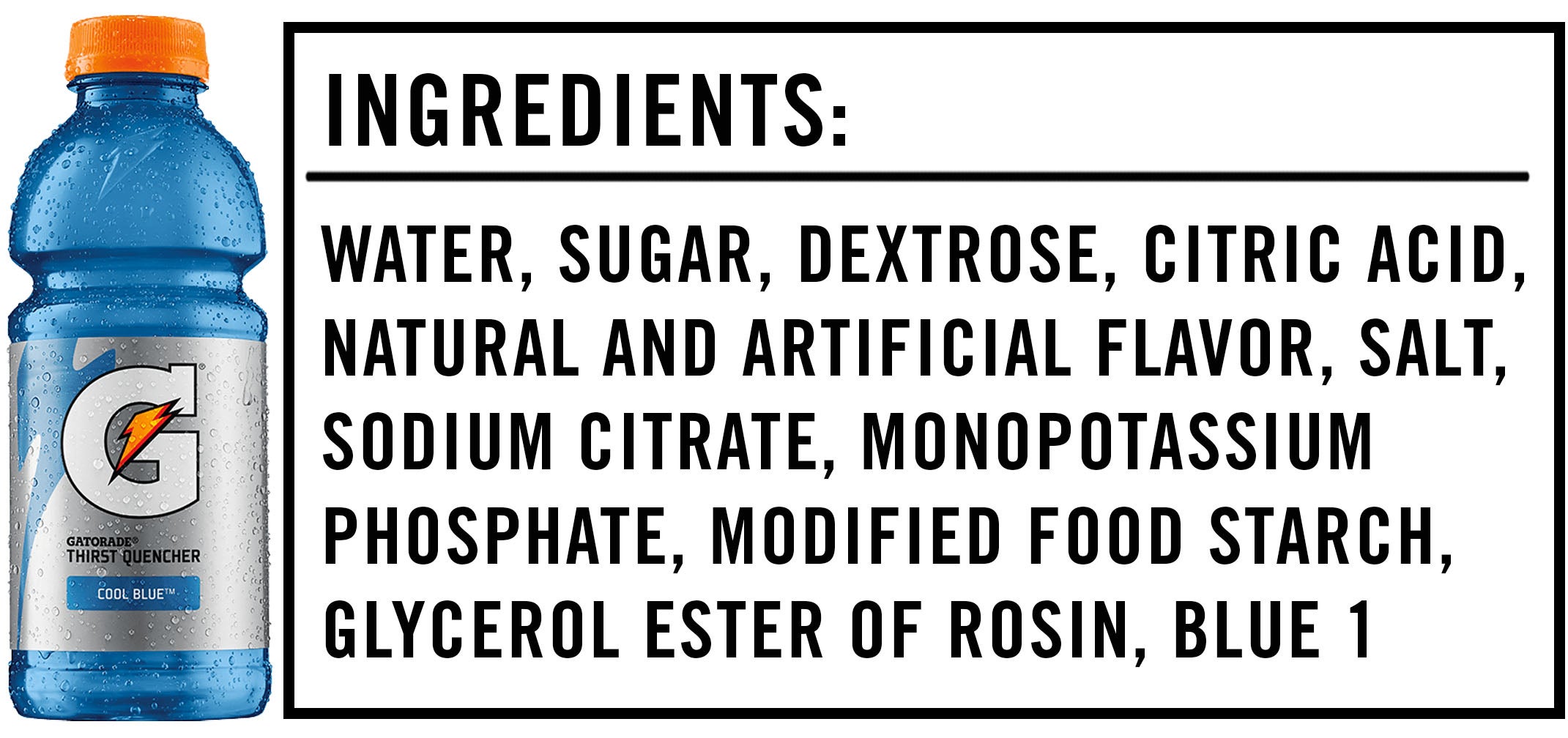We’re often told that you should never eat anything (or put anything on your body) if you don’t recognize everything on the ingredients list. But since most of us have no idea what xanthan gum or potassium benzoate are — or more importantly, what they’re doing to our bodies — we’re decoding the ingredients in the many things Americans put in (and on) themselves with the help of an expert.
This edition: Cool Blue Gatorade, which is made from 11 separate ingredients that we’ve broken down in the exact order they appear on their website.

The Ingredients
1) Water: You (hopefully) already know this one.
2) Sugar: One 20-ounce bottle of Gatorade contains a whopping 34 grams of sugar — for reference, a Snickers bar contains 27 grams. The American Heart Association recommends that men consume no more than 36 grams and that women consume no more than 25 grams of added sugar per day. Too much sugar, if you didn’t already know, is terrible for you: A sugar-laden diet is associated with all kinds of ailments, from heart disease to depression.
3) Dextrose: Dextrose is a sugar derived from starches, like corn. Fun fact: Dextrose has a high glycemic index, meaning it quickly raises blood sugar levels, so it’s used in IV solutions to treat low blood sugar and dehydration. People with diabetes might also consume dextrose tablets to raise their blood sugar if they become dangerously low. Because of this blood-sugar-boosting effect, consuming dextrose also provides an almost immediate jolt of energy — followed by an inevitable crash.
4) Citric Acid: Citric acid is a sour flavoring agent derived from citrus, and it’s often used to keep products like Gatorade fresh while they’re sitting on shelves.
5) Natural and Artificial Flavor: While natural flavors are literally flavors derived from an actual food source — i.e., blueberry flavoring taken from a real blueberry — artificial flavors are chemical compounds created in a lab that mimic a natural flavor in some way. While that may sound unhealthy, as physician and biochemist Cate Shanahan, author of Deep Nutrition: Why Your Genes Need Traditional Food, told us during our exploration of all 26 ingredients in nacho-flavored Doritos, these flavorings are added in such small quantities that they shouldn’t cause you any harm.
6) Salt: In addition to providing flavor, sodium stimulates thirst and helps replace electrolyte losses from sweat — both of which could keep you hydrated.
7) Sodium Citrate: Sodium citrate is the sodium salt of citric acid. It acts as a preservative and can provide a sour taste when added in high amounts.
8) Monopotassium Phosphate: This is probably added to Gatorade as a source of potassium, which is an electrolyte that helps regulate fluid balance, nerve signals and muscle contractions. While monopotassium phosphate is generally recognized as safe — in small amounts — by the Food and Drug Administration (FDA), the trouble with phosphate-based ingredients is that they can potentially raise your phosphate levels to unhealthy amounts. Unfortunately, studies have linked high levels of phosphates with conditions like heart disease, decreased bone density, premature aging, kidney issues and even early death.
9) Modified Food Starch: Modified food starch is extracted from the source (usually corn, potatoes and/or tapioca), then treated physically, enzymatically or chemically to partially break down the starch. It can be used as a stabilizer, thickening agent or an emulsifier — that means it helps the numerous ingredients in Gatorade mix together.
10) Glycerol Ester of Rosin: This is an alternative to brominated vegetable oil, an extremely unhealthy ingredient that was previously used in Gatorade. It ensures that the citrus oils in these sports drinks remain suspended in the water, rather than floating to the top, and it’s generally recognized as safe by the FDA.
11) Blue 1: Blue 1, like many artificial colors, is known to be cancerous. But as Shanahan explained during our analysis of Doritos, studies arguing this are a bit flawed: “I’ve always been of the opinion that studies claiming artificial colors can cause cancer are irrelevant because [in the studies] they use really high amounts of the artificial colors — like, a million times more than you’d ever get [in your] food [throughout your lifetime].”
All in all, the average person’s liver should be able to break down whatever minuscule amount of artificial coloring we consume with food and drink.
The Takeaway
Obviously, the vast amount of sugar in Gatorade is a huge red flag. Then there’s also the big question: Does Gatorade actually provide anything in the form of hydration — and therefore, hangover remediation — that water doesn’t? The sad, but expected answer, according to a 2012 Mother Jones write-up that focuses on a lengthy scientific report on the validity of sports drinks, is: Not really.
“The BMJ papers address two related but distinct questions: Should people who exercise seek to proactively replace fluids lost, or can they rely on thirst to guide them during and after physical activity? And when they rehydrate, do they need all the salts, sugars and other ingredients dumped into sports drinks, or is water fine? The correct answers are: best to rely on thirst, and water is fine. All that stuff about replacing electrolytes and so on you’ve been hearing all these years? Never mind! The evidence doesn’t support it.”
But then, can we really be shocked? Even the Waterboy knew that.

